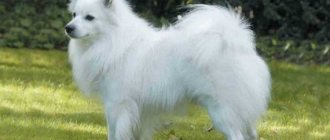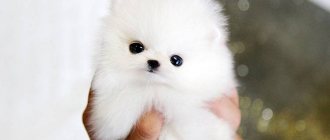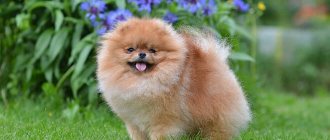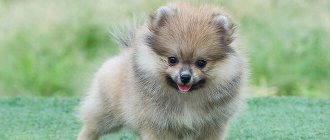Origin story
To understand what difference lies between these two breeds, you need to look into the history of their origin. Many facts indicate that the exterior of all varieties of Spitz is the same. Moreover, obvious differences between animals are observed in their growth. However, not taking into account the Fédération Cynologique Internationale (FCI) standard adopted for this breed, the German Spitz and the Pomeranian have other external differences.
Both species are believed to be descendants of ancient dogs that were used to guard the homes of the poor. After the dogs received recognition from the aristocrats, work began to reduce their size. Differences between these two breeds began to appear after dogs entered the United States in the 20th century. Therefore, European dogs are considered German, and American dogs are considered Pomeranians.
As a result of selection work, the animals of these two breeds have differences in the following indicators:
- origin;
- Name;
- size;
- head;
- wool and its color;
- number of teeth;
- tail;
- the structure of the front paws;
- breeding.
Moreover, according to some indicators, dogs also differ from individuals of other breeds (for example, Japanese Spitz).
In terms of origin, it appears to have appeared naturally under the influence of environmental factors. Therefore, he is distinguished by good health and quick adaptation. The Pomeranian was bred by customers, and therefore is small in size and is a decorative dog for the nobility.
Similar article: History of the origin of the breed and description of the Japanese Spitz
The character and purpose of the dog
What to feed a Spitz: Pomeranian and German
Miniature Spitz are very energetic and inquisitive animals. They are obedient, accept all family members, but they recognize only one leader and obey him. They are supportive of children and can easily entertain them. To help the dog adapt to the company of unfamiliar people and animals, dog handlers advise taking them out for walks in parks and other public places more often. By temperament, pets are cheerful and kind, carefree and friendly.
German miniatures are not capable of living on the street. But they need to be walked 1-2 times a day to maintain physical fitness. In addition, they are quite active and will not mind walks. You can involve dogs in games more often and give commands to maintain their tone. It is believed that these miniature dogs are useful only for aesthetic contemplation. This is partly true: a tiny creature can touch even the sternest person. However, this is not their only function.
Miniatures are excellent companions, especially for a lonely person. They are strongly attached to their owner and serve him faithfully. They are able to adapt to any environment, so they can easily be taken on long journeys. And thanks to their guard sense and ringing bark, they are able to become wonderful guards and, if they do not attack the enemy, then they are quite capable of scaring and warning of his approach.
Color and coat
In addition to height, to distinguish a Pomeranian from a German Spitz, you need to look at the animal’s coat and its color. The “Germans” have a double “fur coat”. It consists of guard hairs, which are straight, stiff and long. In addition, it includes undercoat. It is formed by short and slightly wavy hairs. This type of wool does not require maintenance. It should be washed and combed as needed. Coat color, according to the FCI standard, can be of five varieties: white, brown, black, gray (wolf) and red.
Pomeranians also have a double coat. However, it is formed by a long undercoat, which consists of spirally twisted hairs. In this case, the guard pile is practically absent. Therefore, caring for the fur of such dogs is somewhat more difficult. They need regular haircuts. The coat of this variety can be dyed in various colors.
Features of care
German Spitz (small): description of the breed, character
Since the Miniature Spitz is a small and fluffy dog, care must be appropriate. You need to comb your dog at least 2-4 times a week with a special soft brush, not only to comb, but also to massage the animal’s skin.
Important! To prevent the Spitz's fur from bristling in different directions, it can be lightly sprayed with an antistatic agent.
We should not forget about haircuts, which are done both for aesthetic contemplation and for hygienic purposes (to remove hair from the ears and near the anus). The fur coat can be dried with a hairdryer so that the undercoat does not remain wet. Water procedures should not be carried out often, so as not to remove protective subcutaneous fat. Nail trimming and ear cleaning occurs at least once a month.
For hygienic purposes, the dog needs to have a haircut
Head
In addition to the parameters described above, the differences between both breeds are in the structure of the head. The German variety has a sharp muzzle that looks like a fox cub. There is a smooth transition from the forehead to the muzzle. They also have pointy ears. They are located quite close to each other.
The Pomeranian variety also has small and neat ears. But they are spaced wider on the head. In this case, there is a more pronounced transition from the forehead to the muzzle.
As you can see, you can distinguish a German Spitz from a Pomeranian simply by looking at their head.
Similar article: History of origin and breed standard of the German Miniature Spitz
Similarities and differences
Size
First of all, animals differ in size and weight:
- Germans: height - from 18 to 55 cm, weight - up to 30 kg;
- Pomeranians: height - up to 22 cm (RKF), up to 28 cm (America), weight - up to 3.2 kg.
Appearance
Even a non-professional breeder will immediately notice the difference in these species. In addition to the size (Pomeranians are exclusively dwarf dogs, Germans are dwarf, medium and large), the obvious difference is in the shape of the skeleton. The Germans look elegant and smart. The body is elongated, resembling a rectangle in shape. The bred dwarf pets are denser, and the body fits into a square, so they look more like bears.
Differences in appearance
Colors
The standard colors for the German are orange, black, solid brown, zone gray and white without any signs of yellowness. The top of the hairs should be silver in color with black tips. Red-sable, cream, black-and-tan and cream-sable colors are also acceptable, but without white inclusions.
Different colors
Moreover, if the dog is not monochromatic, the base color can only be white, but the spots can be orange, chocolate, black and gray and located on the body.
Black Spitz dogs should not have white or other colored markings. They must have a black undercoat and the same skin.
Any deviations from standard colors are considered defective, and such animals cannot be accepted for exhibitions.
Standard colors for oranges are:
- red and orange;
- blue, blue and tan;
- white;
- cream;
- chocolate;
- black and tan;
- two-color.
Dogs of different colors
Head
Another important difference is the structure of the head:
- German - the skull is shaped like a fox. The muzzle is narrow, and the frontal line is smoothed; there is a smooth transition from the forehead to the muzzle, which is very weakly expressed. The ears are pointed and set close to each other. There is no edge resembling a hat on the head, the fur is smooth.
- Pomeranian - the skull is shaped like a bear's, only in a mini version. A clear, pronounced transition from the frontal part to the muzzle. The ears are pointed, small in size, widely spaced from each other. The fur covers the head completely and resembles a hat. The entire muzzle is covered with thick fur sticking out in different directions.
Difference in skull structure
Teeth
Despite the same origin story, the number of teeth in dogs differs due to selection work. The Germans have a standard dental formula of 42 teeth; their younger brothers may be missing several premolars.
Forepaws: structure and position
Both species have the same forelimbs in structure - straight, set quite widely. Shoulders with pronounced muscle mass, tightly fitting to the chest. The shoulder blade is oblique and long, the humerus is almost the same length and is located at a right angle. The elbows fit tightly to the chest.
Dogs' paws are practically the same
Forearms of medium length in relation to the body. Stocky and straight, heavily pubescent at the back. The pasterns are strong. The paws themselves are small and round in shape. The fingers resemble a cat's paw.
Regardless of color, the paw pads are black. Let's assume a dark brown color for chocolate Spitz dogs.
The only differences are in the placement of the front paws. The pasterns of Germans are set at an angle of 20 degrees, while those of Pomeranians are perpendicular to the ground.
Tail
Not the least of the differences is the tail. For a German, it is always located above the back, curled into one or a couple of rings. Oranges are lush and dense. The structure is straight. Always lies on his back.
Tail
Another difference between the breeds is the tail. The German variety of Spitz has a tail that can curl into one or two rings. In this case, the tail of animals is always located on top of the back.
The Pomeranian breed, distinguished from other Spitz dogs by its small size and toy appearance, has a straight tail. At the same time, it always lies on the surface of the back.
Now it’s clear how to distinguish one breed from another. After all, for each parameter, the breeds have, although not always obvious, differences.
To whom and who will suit?
The German Spitz has an easy-going character. This is a very balanced animal with unprecedented wariness towards everything alien and incomprehensible.
Hereditary qualities are felt, encouraging one to preserve and protect the family. The aboriginal way of life has instilled many traits: over the long history of the breed’s formation, the dog has become accustomed not only to being close to its owner, but also to vigilantly observing its surroundings. Therefore, the German will become a desirable pet and a wonderful friend for both elderly people and people with disabilities.
The Pomeranian loves movement, and he would be happy with owners who share his passion.
This is an active and cheerful breed that finds it difficult to sit in one place, so the pet will easily take root in families with children and other pets, largely thanks to the ability to find a common language with anyone.
However, this does not apply to very young children who have not yet learned to distinguish between what is and is not possible. The Pomeranian cannot boast of its size, and playing with children can often cause accidents.
Spitz dogs are convenient for people living in apartments, both large and small. Fortunately, pets are unpretentious and do not take up much space.
NOTE!
Another thing is issues of education. German and Pomeranian Spitz require a lot of attention. Their owner must be able to find the time and desire to instill in the pet the basics of training, otherwise the pet’s behavior will become a problem in the future.
So who's better
There is no clear answer as to who is better – an Pomeranian or a German. Both varieties have common stages in their origin, so they are characterized by similar characters, as well as common body structure features.
Both breeds are almost equally trainable. They show love for people, especially children, and get along well with their relatives. But despite their cute appearance, dogs can stand up for themselves and their owners.
It is worth noting that when raising German and Pomeranian Spitz, you should pay a lot of attention to raising your pet. Indeed, in both cases, animals can begin to bark, chew furniture and show aggression towards strangers. Therefore, education and socialization should occupy a leading place in the maintenance of dogs of these breeds.
Similar article: How to quickly train a Spitz to use the toilet or diaper
It may help to clarify the choice that both breeds have different purposes. The German Spitz is more suitable for the role of a watchman or protector. He is larger and has better health. But the Pomeranian is a decorative dog. Moreover, due to the desire of breeders to make it smaller than its ancestors, the animals acquired many health problems. Some subspecies of this breed have disorders of the respiratory system. In addition, they have genetically determined problems with the skeleton (especially the spine). Therefore, you will have to travel to veterinary clinics with this pet.
Thus, if you need a watchdog, then it is better to choose a German. If you need a toy-type lap dog, then the Pomeranian will be an excellent choice.
Knowing the difference between a Pomeranian and a German Spitz, you can easily choose a pet for yourself.
Structure
There are several differences in appearance:
- Head. The German type is small, smooth, without pronounced cheeks and cap. The ears are pointed and set close to each other. The forehead flows smoothly into the pointed muzzle of a fox shape.
The Pomeranian's head resembles a cylinder. The ears are small, set quite widely apart, almost hidden by the fur. The transition from a sloping, strong forehead to a flattened muzzle is more clearly expressed.
- Teeth. The German has a complete set - the number is 42. For the Pomeranian type, the absence of several molars is acceptable.
- Front legs. The German Spitz has very thin coats, without much undercoat, and stands at an angle relative to the ground: about 20°.
Pomeranians have strong, thick paws, like those of a bear, and always keep them perpendicular to the surface on which they stand.
- Tail. For the German, it twists into 1-2 rings and is located above the back. The Pomeranian type has a straight or arched tail.
Video “All about the Pomeranian Spitz breed”
From this video you will learn about what it looks like and why you should get a Pomeranian.
Recommended Posts
Standard height and weight of the Cane Corso breed by month
Description and content of the hunting border terrier
Weight of a puppy and an adult Labrador by month
Weight and height of a German Shepherd puppy by month
38 best dog breeds for apartments according to reviews from breeders and owners
TOP 40 best hunting dog breeds with names, descriptions and photos
Recommendations for breeding
In order for the offspring to take part in exhibitions, both parents must have a high exhibition rating - “good”, as well as documents confirming the pedigree. This is a requirement of the RKF and the International Kennel Club.
Puppy on a walk
But in the USA, Great Britain and Canada, Pomeranians are allowed for breeding without exhibition evaluation. All you need is documents of origin from the nursery.
Choosing a puppy
To be sure of the purity of the breed, it is better to purchase a dwarf Spitz puppy from a specialized nursery. In our country they are not available in every city.
The most famous nurseries:
- HEAVEN HEART (Moscow),
- Velcom Setan (Novosibirsk),
- Santa Fay (Kaluga).
For a puppy with a pedigree and titled parents they can charge between $1500-2000. You can buy a miniature spitz cheaper. But be sure to check all documents for the dog, vaccinations and veterinary passport.
Training and education
The dwarf Spitz quickly learns basic commands. It is worth repeating the command several times to consolidate it and move on to another. Difficulties in education may arise due to the stubbornness and self-will of the breed. Therefore, you need to immediately let the puppy know who is boss in the house and teach him the rules of behavior (do not bark for no reason, do not rush at people). You cannot hit or intimidate a dog. In the process of training, you need to show consistency, perseverance, not let the animal gain the upper hand, and not make concessions.
Distinctive features
Differences in appearance are due to the origin of the animals. The ancestors of the German Spitz are considered to be northern turf dogs. Pomeranians appeared in Pomerania, migrated to Great Britain, and from there to America, where experienced breeders worked on their exterior when the Germans developed their own unique style.
The first difference is size . On the territory of the post-Soviet space this is not so noticeable, because animals are classified as one breed and are crossed randomly. American standards indicate that Germans can reach 20-50 cm at the withers, having several height variations, and the maximum for Pomeranians is 28-30 cm (and they weigh up to 3 kg).
In addition, the differences between the breeds lie in the structure of individual parts of the body:
- The head and muzzle of Spitz with German roots is fox-like, sharp, narrow, wedge-shaped; with Pomeranians - shortened jaw, round skull;
- Pomeranians' ears among the Germans - sharp and significantly raised above the coat;
- The tail for German representatives is necessarily curled over the back, for Pomeranians it is valued straight and short;
- The limbs are thick and strong in Pomeranians, thin and long in Germans.
The colors of German Spitz are dark: gray, sable, tan, black. Pomeranians can be anything, but more often they are red and blond.











